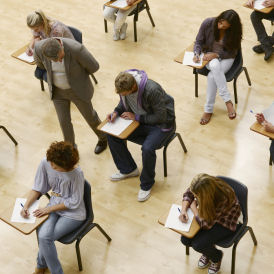Maths A-level boost as languages fall away
As this year’s A-level results show a rise in the pass rate for the 29th year in a row, data also suggests the number of students taking maths has risen dramatically while languages are in decline.

Overall 97.8 per cent of A-level entries received at least an E grade, up from 97.6 per cent last year. It’s the 29th year in a row that the pass rate has increased, and the numbers getting the top A* grade also rose, with one in 12 exams scoring an A*.
Just over one in four exams got at least an A, the same numbers as in 2010.
But, as 250,000 teenagers rip open their results envelopes this morning, the figures also show big changes in the types of A-level that students are choosing to study.
This year biology entries were up by 7.2 per cent, chemistry up 9.2 per cent, physics up 6.1 per cent and mathematics, including further mathematics, up by 7.4 per cent.
I think the message is getting through now, that if you have got mathematics, it is a passport to many, many options. Jim Sinclair, Joint Council for Qualifications
However, traditional modern languages continued to decline, with the numbers for French going down by 4.7 per cent and those for German decreasing by 6.9 per cent.
Maths in particular has seen a dramatic increase in the last five years, with a rise in uptake of 40.2 per cent.
Jim Sinclair, Director of the Joint Council for Qualifications, said: “The increase in the number of students taking maths and the sciences suggest that young people are listening to the repeated calls from industry for more people to study the stem subjects.”
Mark Dawe, Chief Executive of the OCR exam board, added: “I think that the message is getting through now, that if you have got mathematics, it is a passport to many, many options.”
Earlier, Universities minister David Willetts suggested that more “traditional” subjects should be valued more highly in the race for university places.
University scramble
More than 384,000 would-be students are believed to have already had university applications accepted based on their A-level results, according to the latest Ucas figures, while around 185,000 people are eligible for clearing. Both figures are up on last year, said the organisation, which manages applications to universities.
This year is the last year before the increase in tuition fees comes into force, allowing higher education institutions to charge up to £9,000 a year for their courses.
But many were left on tenterhooks to find out if they had got in when the official website which tells them whether their grades have won them a university place crashed. Its the latest blunder to hit this year’s students, who – alongside those taking GCSEs – have also seen impossible questions posed in their papers, wrong answers in multiple choice questions, and printing errors.
Can’t afford a Gap Year? Think again
Missed out on a university place? Take a Gap Year, says spoof backpacker Orlando, “and remember, a gap yah will only cost you an extra 20K. Literally a bargain”. Channel 4 News begs to differ. Read more here.